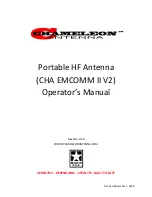
CHA EMCOMM II V2
Page 3
Introduction
Thank you for purchasing and using the Chameleon Antenna
TM
Portable High Frequency (HF) Antenna
(CHA EMCOMM II V2). The CHA EMCOMM II V2 Antenna has been specially designed for backup
emergency HF systems or permanent installation. The integral broadband impedance matching network
transformer allows broadband antenna tuning. The antenna will operate from 1.8 - 54 MHz (including
160m
–
6m amateur bands) without any adjustment with a wide range antenna tuner. The CHA
EMCOMM II V2 is the perfect backup antenna for military, government agencies, non-governmental
organizations (NGOs), Military Affiliate Radio System (MARS), Civil Air Patrol (CAP), Amateur Radio
Emergency Service (ARES) / Radio Amateur Civil Emergency Service (RACES), Salvation Army Team
Emergency Radio Network (SATERN), First Responders and especially for Emergency Preparedness. It is
also the ideal antenna for hams living in apartments and condominiums or developments with
homeowner’s
associations, deed restrictions, or CCRs (Covenants, Conditions & Restrictions). The CHA
EMCOMM II V2 is configurable to facilitate Near-Vertical Incident Sky wave (NVIS) communication and is
totally waterproof. The CHA EMCOMM II V2 does not require any ground plane but will perform better
with one (a ground terminal is available for that purpose). This antenna requires a wide range antenna
tuner or coupler. Antennas built by Chameleon Antenna
TM
are versatile, dependable, stealthy, and built
to last. Please read this operator’s manual so
that you may maximize the utility you obtain from your
CHA EMCOMM II V2.
HF Propagation
HF radio provides relatively inexpensive and reliable local, regional, national, and international voice and
data communication capability. It is especially suitable for undeveloped areas where normal
telecommunications are not available, too costly, or scarce, or where the commercial
telecommunications infrastructure has been damaged by a natural disaster or military conflict.
Although HF radio is a reasonably reliable method of communication, HF radio waves propagate through
a complex and constantly changing environment and are affected by weather, terrain, latitude, time of
day, season, and the 11-year solar cycle. A detailed explanation of the theory of HF radio wave
propagation is beyond the scope of this operator’s manual, but an understanding of the
basic principles
will help the operator decide what frequency and which of the CHA EMCOMM II V2
’s configurations will
support their communication requirements.
HF radio waves propagate from the transmitting antenna to the receiving antenna using two methods:
ground waves and sky waves.
Ground waves are composed of direct waves and surface waves. Direct waves travel directly from the
transmitting antenna to the receiving antenna when they are within the radio line-of-sight. Typically,
this distance is 8 to 14 miles for field stations. Surface waves follow the curvature of the Earth beyond
the radio horizon. They are usable during the day and under optimal conditions, up to around 90 miles,
see table (1). Low power, horizontal antenna polarization, rugged or urban terrain, dense foliage, or


































